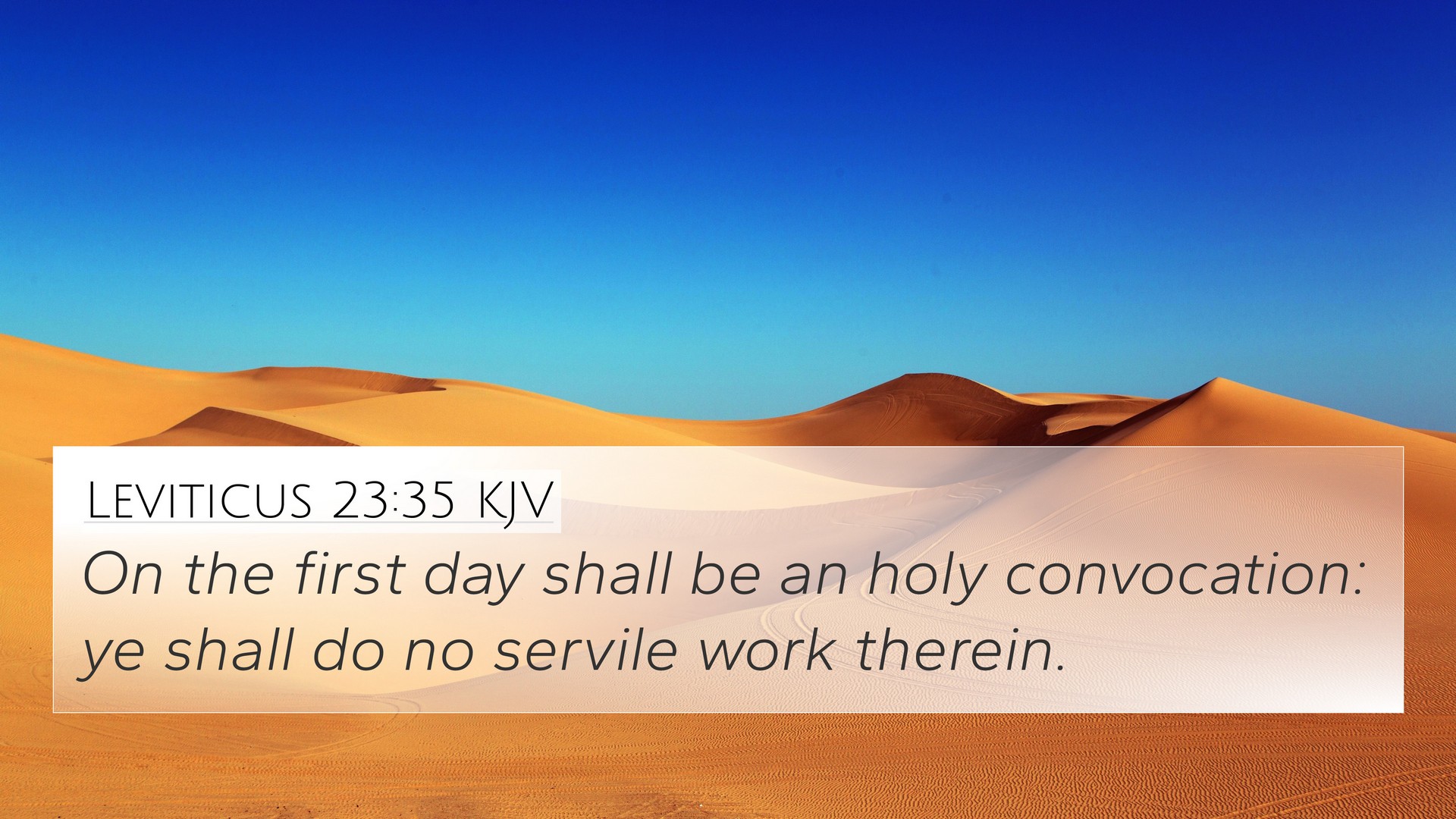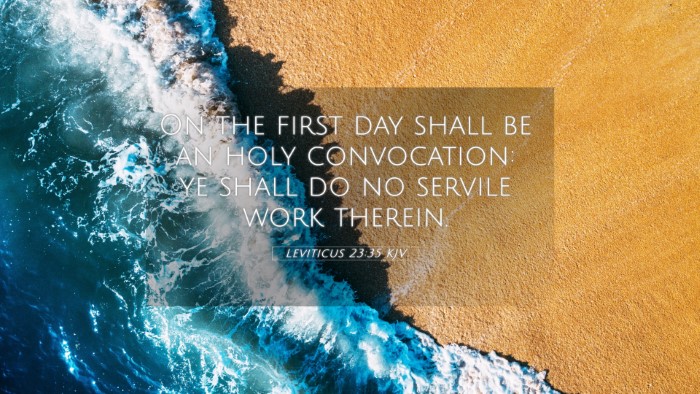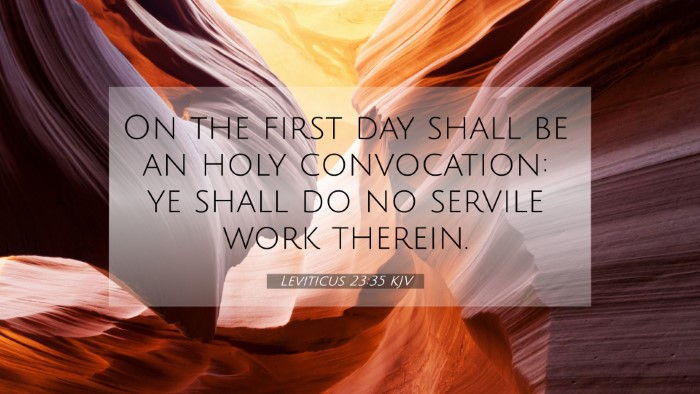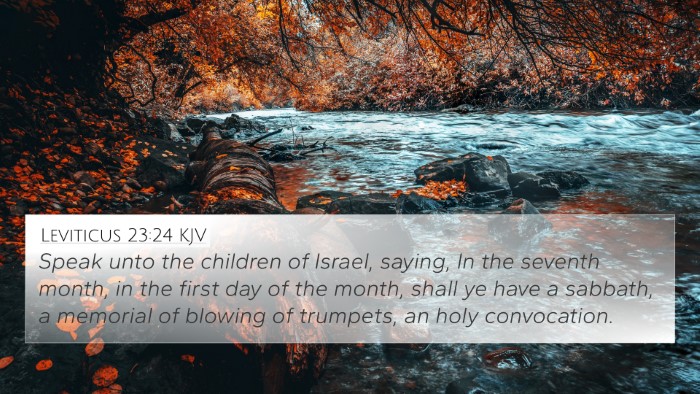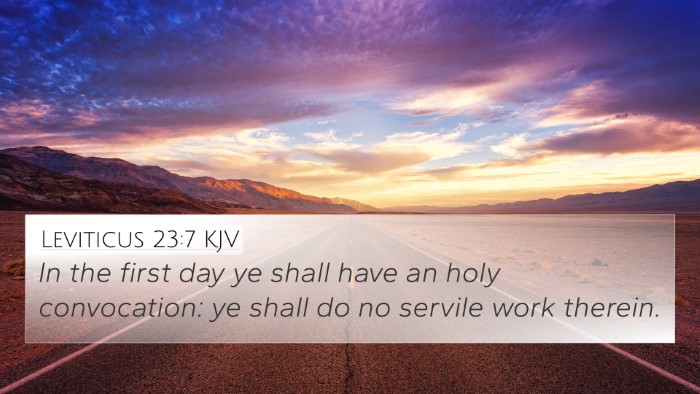Understanding Leviticus 23:35
Verse: Leviticus 23:35 - "On the first day shall be a holy convocation: ye shall do no servile work therein."
This verse addresses the observance of the Feast of Tabernacles (Sukkot), emphasizing the need for a sacred gathering, reinforcing the importance of community and worship.
Meaning and Insights from Commentaries
Matthew Henry's Commentary:
- The verse highlights the significance of setting apart time for spiritual reflection and communal worship.
- Henry notes that the term "holy convocation" implies a solemn assembly, indicating that such gatherings should be treated with reverence.
- This celebration contrasts the routine of daily work, prompting believers to focus on divine worship.
Albert Barnes' Commentary:
- Barnes elaborates that the Feast of Tabernacles serves as a reminder of Israel's wilderness wanderings, and thus the holy convocation brings to memory God’s providence.
- The directive to abstain from servile work emphasizes the prioritization of spiritual duties over mundane tasks during sacred times.
- Barnes also notes that such observances strengthen family and community bonds through shared faith practices.
Adam Clarke's Commentary:
- Clarke insightfully points out that the phrase "no servile work" encourages believers to detach from the busyness of daily life, making time for spiritual engagement.
- He articulates that this festival and its observances represent a joyous time of remembrance and gratitude towards God.
- Clarke also emphasizes that the principle of prioritizing worship over work is a recurring theme throughout the Scriptures.
Cross-References
Leviticus 23:35 is closely related to several other scripture passages that enhance its meaning and context. Here are some key cross-references:
- Exodus 12:16: Discusses the prohibition of work on holy days.
- Exodus 23:12: Reinforces the idea of keeping a holy rest on the Sabbath.
- Deuteronomy 16:15: Highlights the joy associated with the Feast of Tabernacles.
- Leviticus 23:1-3: Introduces the concept of holy gatherings throughout the Israelite calendar.
- John 7:37-38: Refers to the significance of water and worship during the Feast.
- Matthew 5:14: Touches on the concept of being a light in the world, similar to the gathering’s purpose.
- Hebrews 10:25: Encourages gathering for worship, relating to the community aspect of the festival.
Thematic Connections and Analysis
Leviticus 23:35 embeds itself into a broader narrative of faith practices, community involvement, and spiritual observance. The themes can be seen through various lenses:
- Communal Worship: The passage reflects the importance of coming together as a faith community.
- Rest and Reflection: Emphasizes the necessity to take breaks from daily labor for spiritual rejuvenation.
- Gratitude and Remembrance: Invokes a spirit of gratitude, showcasing God's past provisions.
Inter-Biblical Dialogue
The principles laid out in Leviticus 23:35 resonate not only within the Old Testament but find relevance in New Testament teachings as well:
- Jesus' observance of festivals consolidates the principles of these gatherings, showcasing continuity in the importance of communal faith expressions.
- Cross-references between Old Testament feasts and New Testament practices emphasize the seamless evolution of worship in the Christian faith.
- Connecting teachings of the apostles regarding rest and worship reflects the foundational roots established in the Torah.
Tools for Bible Cross-Referencing
In order to delve deeper into the study of biblical connections, utilizing tools for Bible cross-referencing can enhance understanding:
- Bible Concordance: Helps to locate verses and understand their usage throughout scripture.
- Bible Cross-reference Guide: Assists in identifying verses related to specific themes or ideas.
- Cross-reference Bible Study: Engaging with various texts to uncover deeper meanings and connections.
Conclusion
Leviticus 23:35 serves not only as a directive for worship but as an integral part of the Israelites’ identity as God's chosen people. The insights from public domain commentaries underscore its relevance in today’s spiritual practice while the thematic connections illustrate the ongoing dialogue across biblical texts. For anyone aspiring to deepen their understanding of scripture, engaging with cross-referenced verses enhances the journey.
